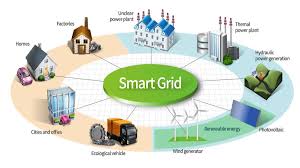
Smart grid model with renewable energy sources in MATLAB Simulink
Introduction to Smart Grids
Smart grids represent the future of electrical power distribution, combining traditional power infrastructure with advanced digital communication technologies. Unlike conventional power grids, smart grids can automatically detect and respond to local changes in usage, integrate renewable energy sources efficiently, and provide real-time information to both utilities and consumers.
In this comprehensive tutorial, we'll explore smart grid concepts through practical MATLAB Simulink simulation, covering:
- Bidirectional power flow management
- Renewable energy integration (Solar & Wind)
- Energy storage systems (Battery & Supercapacitors)
- Load balancing and demand response
- Grid stability and protection systems
Prerequisites
Basic knowledge of electrical circuits, power systems fundamentals, and familiarity with MATLAB/Simulink interface. Understanding of AC power analysis and three-phase systems is recommended.
Smart Grid Components
Before diving into simulation, let's understand the key components that make a grid "smart":
Setting Up the Simulink Model
We'll build a comprehensive smart grid model step by step. Start by opening MATLAB and creating a new Simulink model:
% MATLAB Commands to initialize the workspace
clear all; clc;
% Define simulation parameters
sim_time = 10; % Simulation time in seconds
solar_capacity = 100e3; % 100 kW solar capacity
wind_capacity = 150e3; % 150 kW wind capacity
battery_capacity = 200e3; % 200 kWh battery capacity
base_load = 180e3; % 180 kW base load
% Grid parameters
grid_voltage = 11e3; % 11 kV distribution voltage
grid_frequency = 50; % 50 Hz
1. Traditional Grid Source
First, let's model the traditional grid connection:
% Grid Source Block Configuration
% Use: Three-Phase Source (Simulink/SimPowerSystems/Electrical Sources)
% Parameters:
% - Peak line-to-line voltage: 11000*sqrt(2) V
% - Frequency: 50 Hz
% - Phase angle: 0 degrees
% - Internal resistance: 0.01 ohm
% - Internal inductance: 1e-6 H2. Solar Power Generation
Model a solar PV system with MPPT controller:
function [P_solar, V_dc] = solarPVModel(irradiance, temperature)
% Solar PV model with temperature and irradiance variation
% Standard conditions
G_std = 1000; % W/m^2
T_std = 25; % °C
% PV module parameters
V_oc = 40; % Open circuit voltage
I_sc = 8.5; % Short circuit current
V_mp = 32; % Voltage at maximum power
I_mp = 7.8; % Current at maximum power
% Temperature coefficients
alpha = 0.0032; % Current temperature coefficient
beta = -0.0032; % Voltage temperature coefficient
% Calculate actual values
I_sc_actual = I_sc * (irradiance/G_std) * (1 + alpha*(temperature-T_std));
V_oc_actual = V_oc * (1 + beta*(temperature-T_std));
% Simplified MPPT - assume operating at 80% of Voc
V_dc = 0.8 * V_oc_actual;
I_dc = I_sc_actual * 0.9; % Simplified current calculation
P_solar = V_dc * I_dc;
end3. Wind Power Generation
Implement a wind turbine model with variable wind speed:
function P_wind = windTurbineModel(wind_speed)
% Wind turbine power curve
% Turbine specifications
P_rated = 150e3; % 150 kW rated power
v_cut_in = 3; % Cut-in wind speed (m/s)
v_rated = 12; % Rated wind speed (m/s)
v_cut_out = 25; % Cut-out wind speed (m/s)
if wind_speed < v_cut_in || wind_speed > v_cut_out
P_wind = 0;
elseif wind_speed < v_rated
% Cubic relationship in Region 2
P_wind = P_rated * ((wind_speed - v_cut_in)/(v_rated - v_cut_in))^3;
else
% Constant power in Region 3
P_wind = P_rated;
end
% Add turbulence factor
turbulence = 1 + 0.1*randn(); % 10% turbulence
P_wind = P_wind * max(0, turbulence);
endEnergy Storage System
Implement a battery energy storage system with state-of-charge management:
function [P_battery, SOC] = batteryModel(P_demand, P_generation, SOC_prev, dt)
% Battery Energy Storage System model
% Battery parameters
capacity = 200e3; % 200 kWh capacity
efficiency_charge = 0.95;
efficiency_discharge = 0.95;
SOC_min = 0.2; % Minimum 20% SOC
SOC_max = 0.9; % Maximum 90% SOC
max_charge_power = 100e3; % 100 kW max charging
max_discharge_power = 100e3; % 100 kW max discharging
% Calculate power imbalance
P_imbalance = P_generation - P_demand;
if P_imbalance > 0 && SOC_prev < SOC_max
% Excess generation - charge battery
P_battery = -min(P_imbalance * efficiency_charge, max_charge_power);
% Update SOC
energy_change = -P_battery * dt / 3600; % Convert to kWh
SOC = SOC_prev + energy_change / capacity;
SOC = min(SOC, SOC_max);
elseif P_imbalance < 0 && SOC_prev > SOC_min
% Deficit - discharge battery
P_battery = min(-P_imbalance / efficiency_discharge, max_discharge_power);
% Update SOC
energy_change = P_battery * dt / 3600; % Convert to kWh
SOC = SOC_prev - energy_change / capacity;
SOC = max(SOC, SOC_min);
else
% No battery action
P_battery = 0;
SOC = SOC_prev;
end
endLoad Modeling and Demand Response
Smart grids enable demand response - the ability to modify consumer demand patterns:
function [P_load, P_critical, P_flexible] = smartLoadModel(t, price_signal)
% Smart load model with demand response capability
% Base load profile (typical residential/commercial)
hour = mod(t/3600, 24); % Convert time to hour of day
% Typical daily load curve
if hour >= 0 && hour < 6
base_factor = 0.6; % Low demand during night
elseif hour >= 6 && hour < 9
base_factor = 0.9; % Morning peak
elseif hour >= 9 && hour < 17
base_factor = 0.8; % Daytime
elseif hour >= 17 && hour < 22
base_factor = 1.0; % Evening peak
else
base_factor = 0.7; % Late evening
end
% Critical load (cannot be reduced)
P_critical = 120e3 * base_factor * 0.6; % 60% of load is critical
% Flexible load (can respond to price signals)
base_flexible = 120e3 * base_factor * 0.4; % 40% is flexible
% Demand response based on price
price_threshold = 0.15; % $/kWh threshold
if price_signal > price_threshold
% Reduce flexible load when prices are high
reduction_factor = min(0.5, (price_signal - price_threshold) * 2);
P_flexible = base_flexible * (1 - reduction_factor);
else
P_flexible = base_flexible;
end
P_load = P_critical + P_flexible;
endGrid Control and Optimization
Implement an energy management system that optimizes power flow:
function control_signals = energyManagementSystem(grid_data)
% Energy Management System - optimization and control
% Extract current state
P_solar = grid_data.solar_power;
P_wind = grid_data.wind_power;
P_load = grid_data.load_demand;
SOC = grid_data.battery_soc;
grid_price = grid_data.electricity_price;
% Total renewable generation
P_renewable = P_solar + P_wind;
% Initialize control signals
control_signals.battery_mode = 'standby';
control_signals.grid_import = 0;
control_signals.load_shed = 0;
% Power balance calculation
P_balance = P_renewable - P_load;
if P_balance > 50e3 && SOC < 0.9
% Excess renewable power - charge battery
control_signals.battery_mode = 'charge';
control_signals.battery_power = min(P_balance, 100e3);
elseif P_balance < -20e3 && SOC > 0.3
% Power deficit - discharge battery
control_signals.battery_mode = 'discharge';
control_signals.battery_power = min(-P_balance, 100e3);
P_balance = P_balance + control_signals.battery_power;
end
% Grid interaction
if P_balance < -10e3
% Still have deficit - import from grid
control_signals.grid_import = -P_balance;
elseif P_balance > 10e3
% Excess power - export to grid (if allowed)
control_signals.grid_export = P_balance;
end
% Emergency load shedding if needed
if control_signals.grid_import > 200e3 % Grid import limit
excess_demand = control_signals.grid_import - 200e3;
control_signals.load_shed = excess_demand;
control_signals.grid_import = 200e3;
end
endSimulation Results and Analysis
Run the complete simulation and analyze the results:
% Complete simulation script
function runSmartGridSimulation()
% Simulation parameters
dt = 0.1; % Time step (seconds)
t_end = 86400; % 24 hours simulation
t = 0:dt:t_end;
n = length(t);
% Initialize result arrays
results.time = t;
results.solar_power = zeros(1, n);
results.wind_power = zeros(1, n);
results.load_demand = zeros(1, n);
results.battery_power = zeros(1, n);
results.battery_soc = zeros(1, n);
results.grid_power = zeros(1, n);
% Initial conditions
SOC = 0.5; % 50% initial SOC
% Run simulation
for i = 1:n
current_time = t(i);
% Environmental conditions (varying throughout the day)
irradiance = 1000 * max(0, sin(pi * current_time / 43200)); % Solar irradiance
temperature = 25 + 10 * sin(pi * current_time / 43200); % Temperature variation
wind_speed = 8 + 4 * sin(pi * current_time / 21600) + randn(); % Wind variation
% Generate power from renewables
[P_solar, ~] = solarPVModel(irradiance, temperature);
P_wind = windTurbineModel(wind_speed);
% Calculate load demand
electricity_price = 0.1 + 0.05 * sin(pi * current_time / 43200); % Variable pricing
[P_load, ~, ~] = smartLoadModel(current_time, electricity_price);
% Battery management
P_renewable = P_solar + P_wind;
[P_battery, SOC] = batteryModel(P_load, P_renewable, SOC, dt);
% Grid power (positive = import, negative = export)
P_grid = P_load - P_renewable - P_battery;
% Store results
results.solar_power(i) = P_solar;
results.wind_power(i) = P_wind;
results.load_demand(i) = P_load;
results.battery_power(i) = P_battery;
results.battery_soc(i) = SOC;
results.grid_power(i) = P_grid;
end
% Plot results
plotSmartGridResults(results);
end
function plotSmartGridResults(results)
figure('Position', [100, 100, 1200, 800]);
% Power flow subplot
subplot(2,2,1);
plot(results.time/3600, results.solar_power/1000, 'y-', 'LineWidth', 2);
hold on;
plot(results.time/3600, results.wind_power/1000, 'b-', 'LineWidth', 2);
plot(results.time/3600, results.load_demand/1000, 'r-', 'LineWidth', 2);
plot(results.time/3600, results.grid_power/1000, 'k-', 'LineWidth', 2);
xlabel('Time (hours)');
ylabel('Power (kW)');
title('Smart Grid Power Flow');
legend('Solar', 'Wind', 'Load', 'Grid', 'Location', 'best');
grid on;
% Battery status subplot
subplot(2,2,2);
yyaxis left;
plot(results.time/3600, results.battery_power/1000, 'g-', 'LineWidth', 2);
ylabel('Battery Power (kW)');
yyaxis right;
plot(results.time/3600, results.battery_soc*100, 'm-', 'LineWidth', 2);
ylabel('SOC (%)');
xlabel('Time (hours)');
title('Battery Energy Storage System');
grid on;
% Energy balance subplot
subplot(2,2,3);
renewable_energy = (results.solar_power + results.wind_power)/1000;
plot(results.time/3600, renewable_energy, 'g-', 'LineWidth', 2);
hold on;
plot(results.time/3600, results.load_demand/1000, 'r-', 'LineWidth', 2);
xlabel('Time (hours)');
ylabel('Power (kW)');
title('Renewable vs Load');
legend('Renewable Generation', 'Load Demand', 'Location', 'best');
grid on;
% Grid interaction subplot
subplot(2,2,4);
grid_import = max(0, results.grid_power/1000);
grid_export = max(0, -results.grid_power/1000);
plot(results.time/3600, grid_import, 'r-', 'LineWidth', 2);
hold on;
plot(results.time/3600, grid_export, 'b-', 'LineWidth', 2);
xlabel('Time (hours)');
ylabel('Power (kW)');
title('Grid Interaction');
legend('Import from Grid', 'Export to Grid', 'Location', 'best');
grid on;
endKey Performance Indicators
Monitor renewable energy penetration (%), grid import/export balance, battery utilization, load factor, and power quality metrics to evaluate smart grid performance.
Advanced Features
1. Voltage Regulation
Smart grids must maintain voltage within acceptable limits despite variable generation:
function V_regulated = voltageRegulation(V_measured, P_reactive)
% Automatic Voltage Regulator for smart grid
V_reference = 1.0; % Per unit reference voltage
V_tolerance = 0.05; % ±5% tolerance
% PI controller parameters
Kp = 2.0;
Ki = 0.5;
persistent integral_error;
if isempty(integral_error)
integral_error = 0;
end
% Calculate error
voltage_error = V_reference - V_measured;
integral_error = integral_error + voltage_error;
% PI controller output
Q_correction = Kp * voltage_error + Ki * integral_error;
% Apply reactive power correction
P_reactive_new = P_reactive + Q_correction;
% Simplified voltage calculation
V_regulated = V_measured + 0.1 * Q_correction;
% Limit voltage within acceptable range
V_regulated = max(V_reference - V_tolerance, ...
min(V_reference + V_tolerance, V_regulated));
end2. Fault Detection and Protection
function fault_status = faultDetection(I_measured, V_measured)
% Smart grid fault detection system
% Protection settings
I_threshold = 1.5; % 150% of rated current
V_threshold_low = 0.8; % 80% of rated voltage
V_threshold_high = 1.2; % 120% of rated voltage
fault_status.overcurrent = max(I_measured) > I_threshold;
fault_status.undervoltage = min(V_measured) < V_threshold_low;
fault_status.overvoltage = max(V_measured) > V_threshold_high;
fault_status.any_fault = fault_status.overcurrent || ...
fault_status.undervoltage || ...
fault_status.overvoltage;
if fault_status.any_fault
fprintf('FAULT DETECTED: ');
if fault_status.overcurrent
fprintf('Overcurrent ');
end
if fault_status.undervoltage
fprintf('Undervoltage ');
end
if fault_status.overvoltage
fprintf('Overvoltage ');
end
fprintf('\n');
end
endSimulation Limitations
Remember that these are simplified models for educational purposes. Real smart grid systems involve complex dynamics, detailed power electronics models, and sophisticated control algorithms that require more advanced simulation tools.
Benefits of Smart Grid Technology
| Benefit | Traditional Grid | Smart Grid |
|---|---|---|
| Renewable Integration | Limited, causes instability | High integration with stability |
| Outage Detection | Customer calls required | Automatic detection |
| Energy Efficiency | Fixed consumption patterns | Demand response optimization |
| Power Quality | Basic regulation | Advanced monitoring & control |
Future Developments
The evolution of smart grids continues with emerging technologies:
- Artificial Intelligence: Machine learning for predictive maintenance and optimization
- Blockchain: Peer-to-peer energy trading and secure transactions
- 5G Communication: Ultra-low latency for real-time control
- Edge Computing: Distributed intelligence at grid nodes
- Electric Vehicle Integration: V2G (Vehicle-to-Grid) capabilities
Conclusion
Smart grid simulation using MATLAB Simulink provides invaluable insights into modern power system operation. The integration of renewable energy sources, energy storage, and intelligent control systems creates a more resilient, efficient, and sustainable electrical grid.
This tutorial covered the fundamental aspects of smart grid modeling, from individual component models to system-level optimization. The simulation framework can be extended to explore specific aspects like microgrid operation, electric vehicle integration, or advanced protection schemes.
